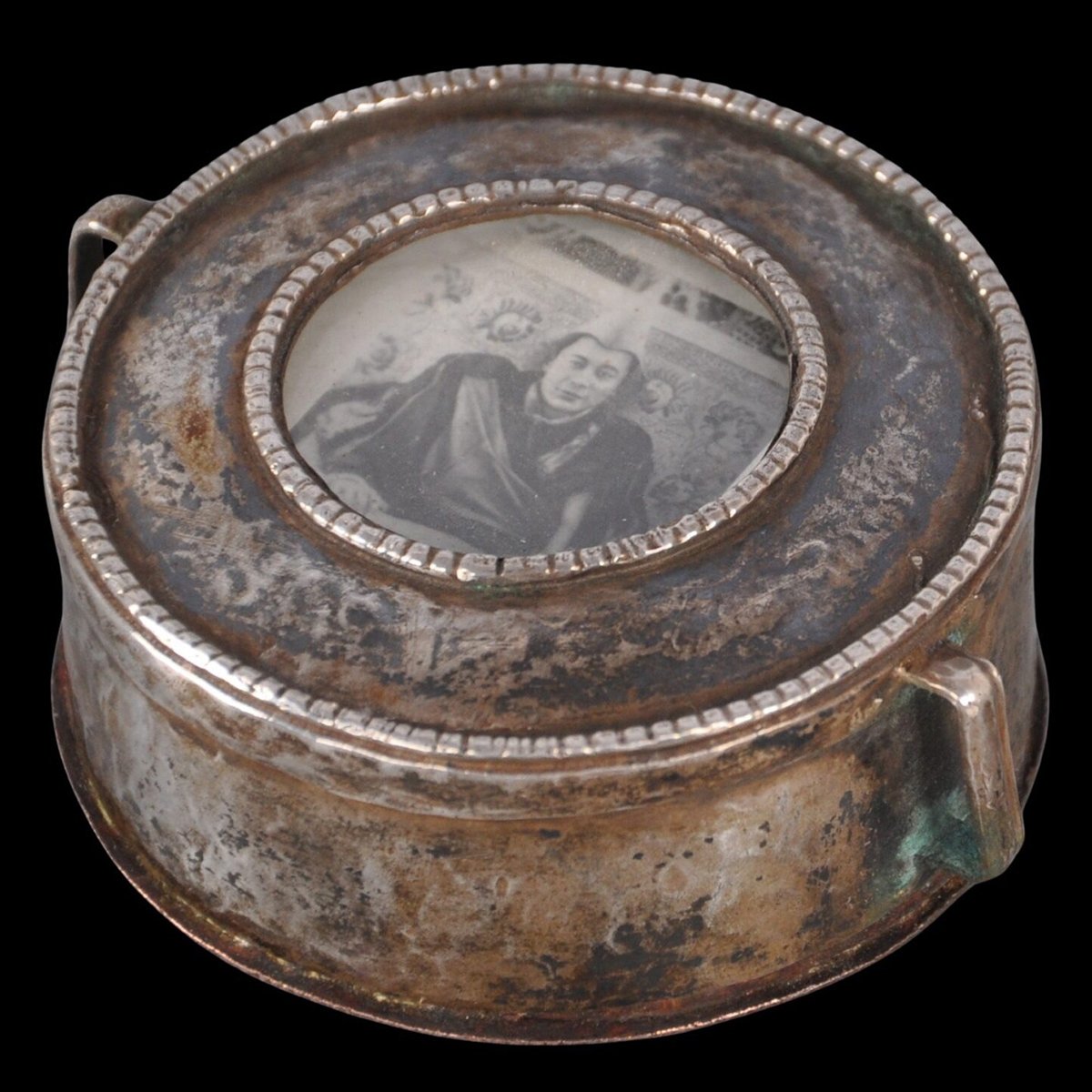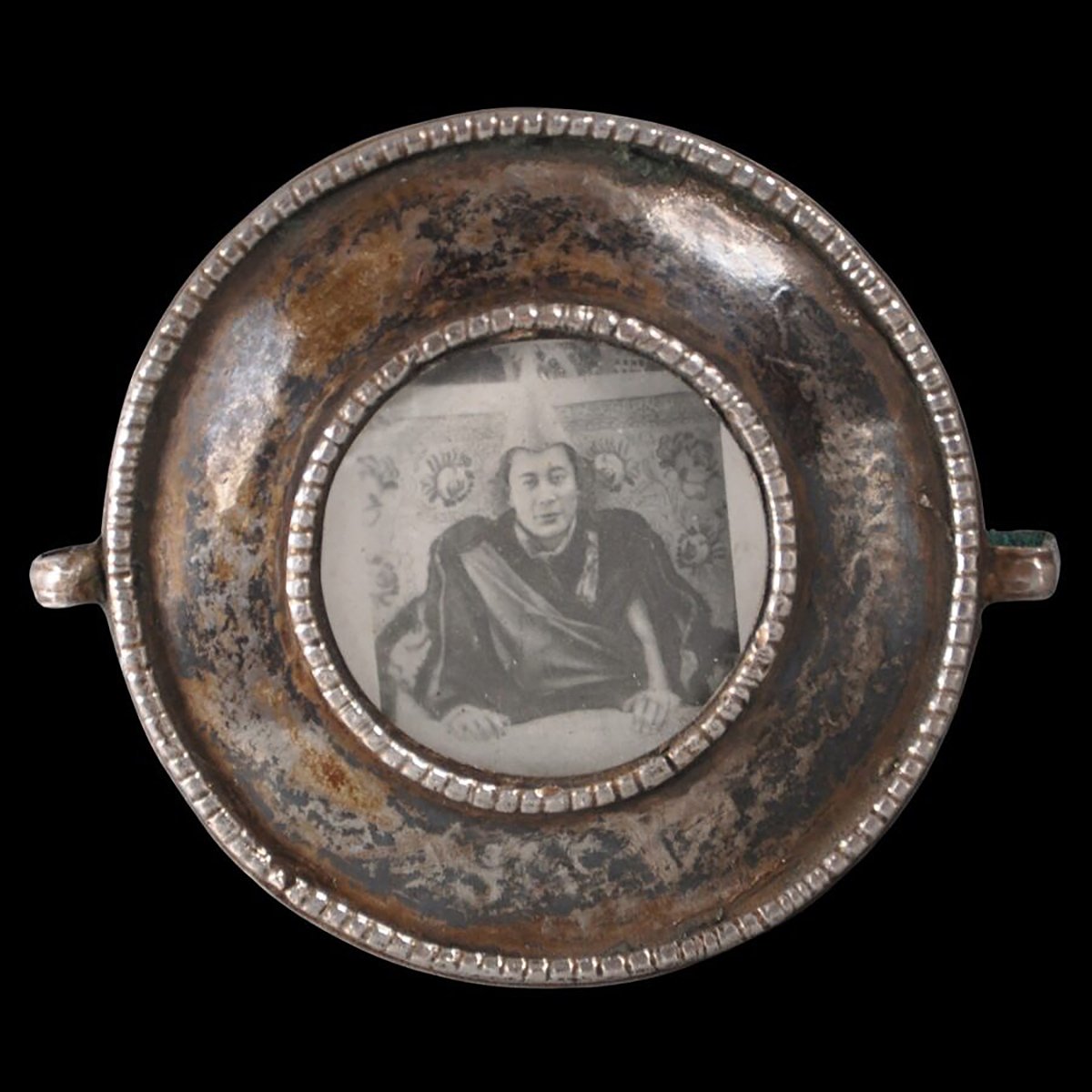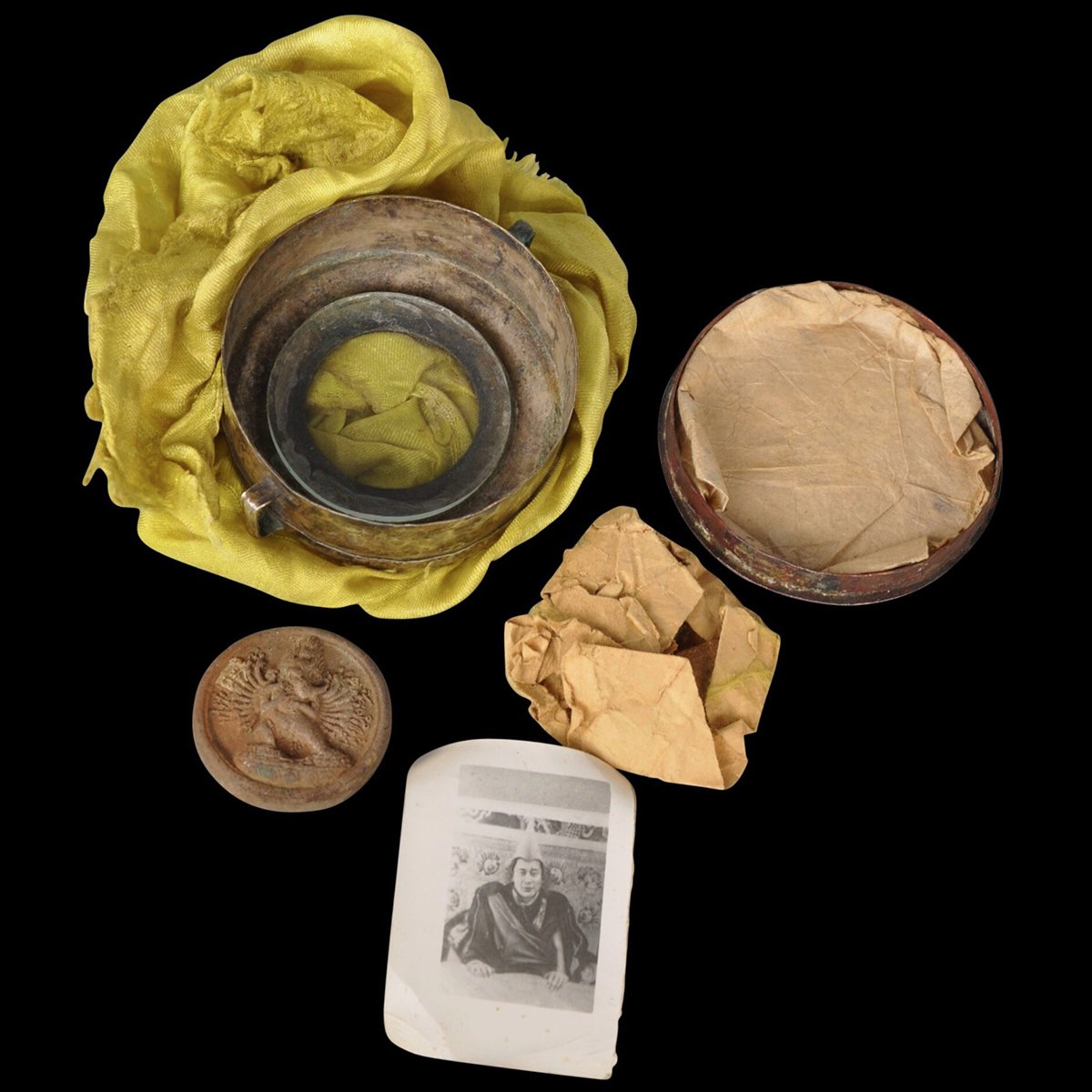 Image 1 of 3
Image 1 of 3

 Image 2 of 3
Image 2 of 3

 Image 3 of 3
Image 3 of 3




Tibetan Gau Box
Tibetan Gau Box with Dalai Lama Photo and relics
Mid-20th century
Height 1 1/4"
Diameter 2 3/4"
Provenance: London Trade
This round ga’u box is of silver and silvered copper. It has a round window in the front that is covered with glass and behind which there is an early photograph of the current Dalai Lama, taken in the 1950s.
The box also contains other relics – such as a clay votive plaque of tsa-tsa showing the deity Vajrabhairava, some yellow silk cloth, and some unidentified scrapings wrapped in some paper. It is possible that the yellow silk has been cut from a ceremonial scarf or khata used in blessings.
The photograph shows the 14th Dalai Lama, Tenzin Gyatso, photographed most probably at the Potala Palace some time during the 1950s and before his exile from Tibet in 1959. The Dalai Lama is the leader and a monk of the dominant Gelug school of Tibetan Buddhism, and formerly was the head of state and government in Tibet.
Vajrabhairava is a wrathful deity in Tibetan Buddhism, particularly prominent in the Gelug school. Both the 13th and 14th Dalai Lamas have maintained an especially close adherence to Vajrabhairava as a meditational deity, hence it is appropriate that an image of this deity should be found in this ga’u box along with an early photograph of the 14th Dalai Lama.
The box has a lug on each side to allow suspension. The reverse has a tightly-fitting backing plate.
Ga’u boxes were worn by men and women in Tibet and in other parts of the Buddhist Himalayas as protective amulet cases. Usually, they were worn suspended from the neck. They would contain a variety of precious and protective items such as parchment inscribed with mantras and cloth perhaps from the robe of an esteemed monk.
It is likely that the Dalai Lama photograph and relics are original to the box. Accordingly, it is an uncommon relic of Tibetan Buddhism from the period when the Dalai Lama was still in power in Tibet. Rare!
References: Geoffrey-Schneiter, B., Bijoux des Toits du Monde de la Chine au Caucase, Foundation Baur, Musee des Artes D’Extreme-Orient/5 Continents, 2012.
Rawson, P., Sacred Tibet, Thames & Hudson, 1991.
Tibetan Gau Box with Dalai Lama Photo and relics
Mid-20th century
Height 1 1/4"
Diameter 2 3/4"
Provenance: London Trade
This round ga’u box is of silver and silvered copper. It has a round window in the front that is covered with glass and behind which there is an early photograph of the current Dalai Lama, taken in the 1950s.
The box also contains other relics – such as a clay votive plaque of tsa-tsa showing the deity Vajrabhairava, some yellow silk cloth, and some unidentified scrapings wrapped in some paper. It is possible that the yellow silk has been cut from a ceremonial scarf or khata used in blessings.
The photograph shows the 14th Dalai Lama, Tenzin Gyatso, photographed most probably at the Potala Palace some time during the 1950s and before his exile from Tibet in 1959. The Dalai Lama is the leader and a monk of the dominant Gelug school of Tibetan Buddhism, and formerly was the head of state and government in Tibet.
Vajrabhairava is a wrathful deity in Tibetan Buddhism, particularly prominent in the Gelug school. Both the 13th and 14th Dalai Lamas have maintained an especially close adherence to Vajrabhairava as a meditational deity, hence it is appropriate that an image of this deity should be found in this ga’u box along with an early photograph of the 14th Dalai Lama.
The box has a lug on each side to allow suspension. The reverse has a tightly-fitting backing plate.
Ga’u boxes were worn by men and women in Tibet and in other parts of the Buddhist Himalayas as protective amulet cases. Usually, they were worn suspended from the neck. They would contain a variety of precious and protective items such as parchment inscribed with mantras and cloth perhaps from the robe of an esteemed monk.
It is likely that the Dalai Lama photograph and relics are original to the box. Accordingly, it is an uncommon relic of Tibetan Buddhism from the period when the Dalai Lama was still in power in Tibet. Rare!
References: Geoffrey-Schneiter, B., Bijoux des Toits du Monde de la Chine au Caucase, Foundation Baur, Musee des Artes D’Extreme-Orient/5 Continents, 2012.
Rawson, P., Sacred Tibet, Thames & Hudson, 1991.
Tibetan Gau Box with Dalai Lama Photo and relics
Mid-20th century
Height 1 1/4"
Diameter 2 3/4"
Provenance: London Trade
This round ga’u box is of silver and silvered copper. It has a round window in the front that is covered with glass and behind which there is an early photograph of the current Dalai Lama, taken in the 1950s.
The box also contains other relics – such as a clay votive plaque of tsa-tsa showing the deity Vajrabhairava, some yellow silk cloth, and some unidentified scrapings wrapped in some paper. It is possible that the yellow silk has been cut from a ceremonial scarf or khata used in blessings.
The photograph shows the 14th Dalai Lama, Tenzin Gyatso, photographed most probably at the Potala Palace some time during the 1950s and before his exile from Tibet in 1959. The Dalai Lama is the leader and a monk of the dominant Gelug school of Tibetan Buddhism, and formerly was the head of state and government in Tibet.
Vajrabhairava is a wrathful deity in Tibetan Buddhism, particularly prominent in the Gelug school. Both the 13th and 14th Dalai Lamas have maintained an especially close adherence to Vajrabhairava as a meditational deity, hence it is appropriate that an image of this deity should be found in this ga’u box along with an early photograph of the 14th Dalai Lama.
The box has a lug on each side to allow suspension. The reverse has a tightly-fitting backing plate.
Ga’u boxes were worn by men and women in Tibet and in other parts of the Buddhist Himalayas as protective amulet cases. Usually, they were worn suspended from the neck. They would contain a variety of precious and protective items such as parchment inscribed with mantras and cloth perhaps from the robe of an esteemed monk.
It is likely that the Dalai Lama photograph and relics are original to the box. Accordingly, it is an uncommon relic of Tibetan Buddhism from the period when the Dalai Lama was still in power in Tibet. Rare!
References: Geoffrey-Schneiter, B., Bijoux des Toits du Monde de la Chine au Caucase, Foundation Baur, Musee des Artes D’Extreme-Orient/5 Continents, 2012.
Rawson, P., Sacred Tibet, Thames & Hudson, 1991.

